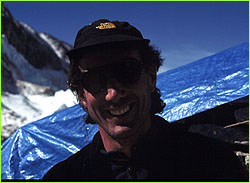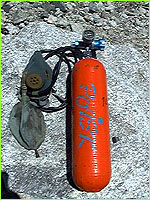 |
 Hear Athans via RealAudio: 28.8 | ISDN |
 |
 Interview with Pete Athans
Interview with Pete AthansDeputy Expedition Leader NOVA: Why are you going back to Everest this time?..... Athans: What's different this time is basically I had a really gut wrenching decision to make some time around December when this project came into fruition and seemed to become a real possibility to join. I had more or less decided to not return to guide on Everest, specifically because of what had happened to Rob Hall and Scott Fischer and a number of people last spring which of course are very well chronicled. I had to examine my motives for being on a mountain that high with people who were novices at best and who certainly did not have the experience that I had. So I was at this crossroads in my life thinking, "well, how do I parlay a dozen years of climbing on Everest and half a dozen years of guiding quite definitively and being one of the best guys on Everest—how do I parlay that into something else? Where do I take it from there?" I just decided I did not want to spend my time climbing on a mountain as high and as difficult and sometimes as dangerous as Everest is with people who are really not clued into the problems with climbing Everest, the problems of dealing with a difficult Icefall that can move underneath your feet, the problems that we're going to be dealing with in this film with high altitude physiology. And fortunately my family gave me their blessings to go back and try again on the mountain I've been climbing on for the last 12 years, just one more time. NOVA: Are you ever afraid on Everest? |
|
28.8 | ISDN |
Athans: I think I definitely have felt fear, certainly in situations that have compromised my safety, and that chiefly has been climbing in the Icefall with clients who are very very slow. An experienced and acclimatized climber who knows his way through the Icefall can go from Base Camp to Camp I in less than two hours if they are moving very well. I've been in the Icefall as long as 15 hours with clients going to Camp I and there are times when I've really examined my motives for being there with clients and felt like my safety was compromised. But a lot of times when I'm climbing I'm just so focused on what I'm doing—where each foot's going, where my hands are going—and I don't really think about fear that much. NOVA: Have you experienced any long-term mental or motor skill loss, even mild, from your previous climbs on Everest, or at altitude? | |
|
28.8 | ISDN |
Athans: Definitely some short-term things, absolutely. In 1994 we went with a group of our clients to the South Col thinking that we would of course summit with them the next day. What we ended up doing was spending four nights on the South Col, climbing the next day after the fourth night, and then having another night on the South Col and then going down. And I definitely remember feeling on the way, the way below Base Camp having some problems with short-term memory, just having a problem remembering names of people who I had known for many years, and also just details like how many loads we packed in Base Camp, stuff that I usually know quite well, and work details of our agenda or my zipcode at home. NOVA: Let's talk about some of the technology that we're using on this trip, for example with our access to e-mail and with the sat phone and laptop computers. How has this technology affected climbing and do you enjoy those luxuries, or would you prefer to be without? | |
|
28.8 | ISDN |
Athans: It's a double-edged sword to have that kind of technology. Any time you have anything really coming between you and the experience of actually climbing it's a compromise to yourself. I know that to me I go to these types of places to try to simplify my life and to get away from a ringing telephone and to get away from the constant bombardment of media and entertainment and just the constant distractions to life that we often have in the West and in that way it is a complete distraction. It also happens to be expensive. It also happens to be difficult to get it to Base Camp in one piece, then make it all work and be compatible, and this is a big challenge for us. But it also offers an incredible opportunity for us to communicate with people why we do what we do and I think to try to—if not justify what we do—at least to try to explain why we do it. And it's not because we're a bunch of knuckle heads up here with a death wish and we're mad men up here, pushing the limits in a place that we really should not be, but it's a place that we go to because we feel like we're alive and we love life and this is how we express that love for life. NOVA: So if you can explain, when do you go on oxygen? | |
|
28.8 | ISDN |
Athans: It depends on you. It depends on your team's composition. If you're with a guided climb, you might start your clients on oxygen at camp III at 23,200 feet, have them climb to the South Col on it first, then they'd sleep on it, climb to the summit on it the next day, come all the way back down and then try to get back down on to Camp III with what's left as well. With a guided trip you have to go very heavy on oxygen, obviously. With a trip like ours, because David [Breashears] of course has climbed three times, I've climbed four times, we know that we can get to the South Col, we've done it before without oxygen. We can rest on the Col, using it only intermittently if at all. And running it at a two-liter flow rate we can get better than seven hours per bottle. So we're looking at a round trip of about 14 hours. That's kind of the limit that we can push it. NOVA: How do the oxygen tanks work? | |
|
28.8 | ISDN |
 Athans: There's just one hose coming out of the top. It's a flexible
rubber hose, it comes into a little bladder that holds air that's attached to
the mask. And then it bleeds into the mask very slowly. You can adjust the
flow rate by a regulator (some people call it the reducer) and you can run it
at one liter or two liter, four liter and six liters. So generally people
don't run it at the high flow rates unless it's for medicinal usages. But
people use it at one liter and two liter mostly when they're climbing, and if
they had stopped oftentimes they'll turn it off just to regulate it. It's kind
of an interesting phenomenon. You could be sitting at 25 or 26,000 feet and
until you move you might not feel very bad at all, you might not be
hyperventilating or anything like that. It's just when you get up and you
start to try and walk uphill and break trail or something, you realize where
you are.
Athans: There's just one hose coming out of the top. It's a flexible
rubber hose, it comes into a little bladder that holds air that's attached to
the mask. And then it bleeds into the mask very slowly. You can adjust the
flow rate by a regulator (some people call it the reducer) and you can run it
at one liter or two liter, four liter and six liters. So generally people
don't run it at the high flow rates unless it's for medicinal usages. But
people use it at one liter and two liter mostly when they're climbing, and if
they had stopped oftentimes they'll turn it off just to regulate it. It's kind
of an interesting phenomenon. You could be sitting at 25 or 26,000 feet and
until you move you might not feel very bad at all, you might not be
hyperventilating or anything like that. It's just when you get up and you
start to try and walk uphill and break trail or something, you realize where
you are. Photos: (1) Liesl Clark; (2) Howard Donner. Lost on Everest | High Exposure | Climb | History & Culture | Earth, Wind, & Ice E-mail | Previous Expeditions | Resources | Site Map | Everest Home Editor's Picks | Previous Sites | Join Us/E-mail | TV/Web Schedule About NOVA | Teachers | Site Map | Shop | Jobs | Search | To print PBS Online | NOVA Online | WGBH © | Updated November 2000 |
|